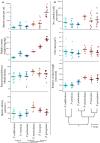Sexual selection drives the coevolution of male and female reproductive traits in Peromyscus mice
- PMID: 36480400
- PMCID: PMC10107626
- DOI: 10.1111/jeb.14126
Sexual selection drives the coevolution of male and female reproductive traits in Peromyscus mice
Abstract
When females mate with multiple partners within a single reproductive cycle, sperm from rival males may compete for fertilization of a limited number of ova, and females may bias the fertilization of their ova by particular sperm. Over evolutionary timescales, these two forms of selection shape both male and female reproductive physiology when females mate multiply, yet in monogamous systems, post-copulatory sexual selection is weak or absent. Here, we examine how divergent mating strategies within a genus of closely related mice, Peromyscus, have shaped the evolution of reproductive traits. We show that in promiscuous species, males exhibit traits associated with increased sperm production and sperm swimming performance, and females exhibit traits that are predicted to limit sperm access to their ova including increased oviduct length and a larger cumulus cell mass surrounding the ova, compared to monogamous species. Importantly, we found that across species, oviduct length and cumulus cell density are significantly correlated with sperm velocity, but not sperm count or relative testes size, suggesting that these female traits may have coevolved with increased sperm quality rather than quantity. Taken together, our results highlight how male and female traits evolve in concert and respond to changes in the level of post-copulatory sexual selection.
Keywords: cryptic female choice; mammals; sexual conflicts; sexual selection; sperm competition.
© 2022 The Authors. Journal of Evolutionary Biology published by John Wiley & Sons Ltd on behalf of European Society for Evolutionary Biology.
Conflict of interest statement
The authors declare no conflicts of interest.
Figures


Similar articles
-
An integrative view of sexual selection in Tribolium flour beetles.Biol Rev Camb Philos Soc. 2008 May;83(2):151-71. doi: 10.1111/j.1469-185X.2008.00037.x. Biol Rev Camb Philos Soc. 2008. PMID: 18429767 Review.
-
Measuring Pre- and Post-Copulatory Sexual Selection and Their Interaction in Socially Monogamous Species with Extra-Pair Paternity.Cells. 2021 Mar 11;10(3):620. doi: 10.3390/cells10030620. Cells. 2021. PMID: 33799610 Free PMC article.
-
Sexual behavior, reproductive physiology and sperm competition in male mammals.Physiol Behav. 2004 Nov 15;83(2):361-71. doi: 10.1016/j.physbeh.2004.08.022. Physiol Behav. 2004. PMID: 15488551 Review.
-
Evolutionary reduction in testes size and competitive fertilization success in response to the experimental removal of sexual selection in dung beetles.Evolution. 2008 Oct;62(10):2580-91. doi: 10.1111/j.1558-5646.2008.00479.x. Epub 2008 Sep 12. Evolution. 2008. PMID: 18691259
-
Why do females mate multiply? A review of the genetic benefits.Biol Rev Camb Philos Soc. 2000 Feb;75(1):21-64. doi: 10.1017/s0006323199005423. Biol Rev Camb Philos Soc. 2000. PMID: 10740892 Review.
Cited by
-
The Known and Unknown About Female Reproductive Tract Mucus Rheological Properties.Bioessays. 2025 Jun;47(6):e70002. doi: 10.1002/bies.70002. Epub 2025 Mar 22. Bioessays. 2025. PMID: 40119784 Free PMC article. Review.
-
Mating system variation and gene expression in the male reproductive tract of Peromyscus mice.Mol Ecol. 2025 Aug;34(15):e17433. doi: 10.1111/mec.17433. Epub 2024 Jun 21. Mol Ecol. 2025. PMID: 39031829 Free PMC article.
-
Sexual Selection on Non-Ornamental Traits Is Underpinned by Evidence of Genetic Constraints on Sex-Biased Expression in Dusky Pipefish.Mol Ecol. 2025 Aug;34(15):e17550. doi: 10.1111/mec.17550. Epub 2024 Oct 14. Mol Ecol. 2025. PMID: 39400380 Free PMC article.
References
-
- Anderson, M. , Dixson, A. S. , & Dixson, A. F. (2006). Mammalian sperm and oviducts are sexually selected: Evidence for co‐evolution. Journal of Zoology, 270(4), 682–686. 10.1111/j.1469-7998.2006.00173.x - DOI
-
- Arnqvist, G. , & Rowe, L. (2005). Sexual conflict. Princeton University Press. 10.1515/9781400850600 - DOI
-
- Bates, D. , Mächler, M. , Bolker, B. , & Walker, S. (2015). ‘Fitting linear mixed‐effects models using’ lme4. arXiv preprint arXiv:1406.5823 .
-
- Beckerman, A. P. , Childs, D. Z. , & Petchey, O. L. (2017). Getting started with R: An introduction for biologists (2nd ed.). Oxford University Press.

